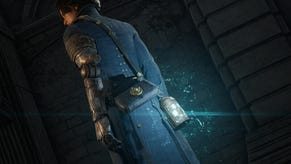Bloodborne Review: Into the Nightmare
Does FromSoftware's latest measure up to the high standard set by Dark Souls? Bob shares his final thoughts on this vast and challenging adventure.
This article first appeared on USgamer, a partner publication of VG247. Some content, such as this article, has been migrated to VG247 for posterity after USgamer's closure - but it has not been edited or further vetted by the VG247 team.
[Editor's note: This was initially a review-in-progress I updated daily while playing through Bloodborne; please note that you can find the final score on page three. And if you need help, turn to USgamer's official Bloodborne guide.]
After the astounding hat-trick of Demon's Souls, Dark Souls, and Dark Souls 2, RPG fans had one question in mind for developer FromSoftware: How could they possibly outdo themselves now?
During the last console cycle, as the increased cost of development caused the mainstream gaming experience to be brief, frictionless, and, at times, barely interactive, this Japanese developer came to the rescue with Demon's Souls, a barely-released (in the USA, at least) action-RPG that proved a healthy challenge didn't necessarily result in retail poison. In the six years since Demon's release, FromSoftware's reworked its formula twice with Dark Souls and its sequel, two critical darlings that will no doubt be remembered as the finest RPGs of their generation.
Bloodborne stands as the latest in their line of Demon's Souls' progeny, but if you're expecting more of the same—honestly, not a terrible prospect for a FromSoftware RPG—prepare to be surprised. While Bloodborne certainly plants its roots firmly within the Souls series, the many alterations director Hidetaka Miyazaki fashioned along the way—some of them drastic—make for a game that rewards the contrary mix of risk-taking and careful observation even more than his previous works. Souls fans may at first balk at how much Bloodborne streamlines the journey they've grown to love over the past half-decade, but these alterations result in a much more focused and intense experience that nonetheless captures its predecessors' adversarial spirit.
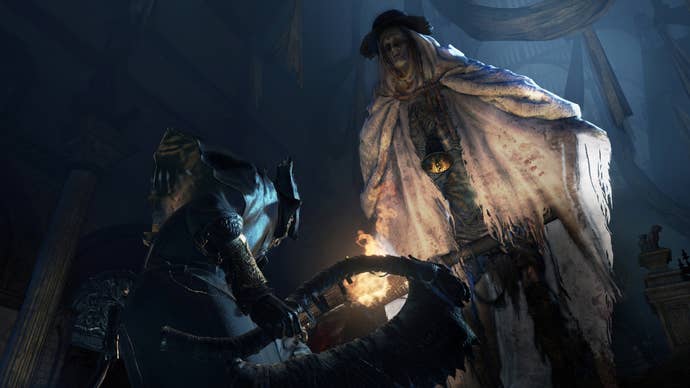
The New Blood
If you've played the Souls series, you won't be completely lost; each of the games' essential qualities manage to find their way to Bloodborne in some form or another. This time around, Souls—the currency for both buying items and leveling up—are called "Blood Echoes," the co-op-activating white soapstones now take the form of bells, and bonfires—those oh-so-welcome checkpoints/fast travel stations—have been replaced with solitary lamps. The inherent philosophy of Souls hasn't gone anywhere, either: As with director Miyazaki's previous games, progress in Bloodborne can only be gained through repeated trial and error to the point where players can blitz wildly through a gauntlet of enemies that, a dozen attempts ago, seemed insurmountable. And, as always, you can grab those dropped Blood Echoes if you reached the point where you previously died—though, in Bloodborne, they're sometimes transferred to the body of the enemy who killed you. Even though I've played hundreds of hours of FromSoftware RPGs over the years, I haven't yet been desensitized to the endorphin rush that happens when you overcome one of their deviously designed challenges—I (embarrassingly) felt compelled to high-five my girlfriend every time I finally killed another boss.
Even though Bloodborne retains those core Souls qualities, Miyazaki isn't at all afraid to streamline the experience—something that's due to cause controversy in the Souls community. Though Bloodborne can't be called anything but an action-RPG, it leans a little closer to the first half of that discriptor than I initially expected. The nine character attributes from Dark Souls 2 have been reduced to just six, and equipment burden—which determines how fast characters move based on the weight of their gear—is gone entirely. Souls specialized in ridiculous amounts of character customization, but there's not as nearly as much wiggle room to be found in Bloodborne; it's very much designed to be played with an in-your-face melee approach, simply because its world doesn't offer many other options. Ranged attacks are weak, sorcery and pyromancy aren't even options (not any that I could find), and, most importantly, Bloodborne completely strips away one of the Souls series' most vital defensive tools: the shield.
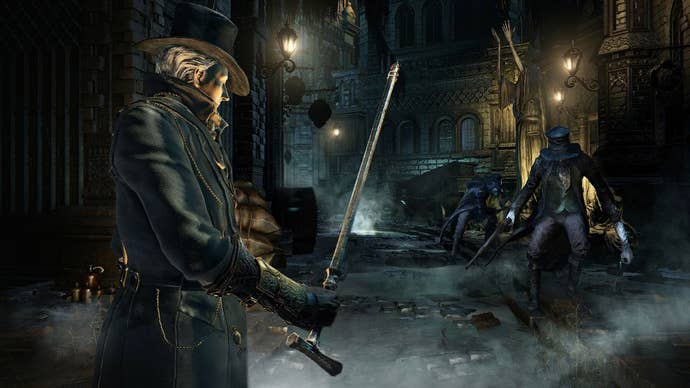
As someone who normally hides behind a hefty steel barrier in Dark Souls, I didn't know if I'd be able to withstand a game of this difficulty without my standard crutch. And, to be honest, I'd be disappointed in Bloodborne's relative lack of character customization if the way it made me play wasn't so engaging. Where combat in Souls is slow and methodical, and typically involves waiting for just the right opening, Bloodborne takes a much more direct approach by encouraging the player to take some serious risks. If an enemy manages to land an attack, you can regain this lost health by successfully striking back immediately afterwards—meaning there's many cases where you'll have no choice but to take a hit just for the sake of getting up close and personal.
The guns in Bloodborne also provide an interesting twist on enemy encounters, replacing the parry and riposte mechanic from Souls with something that feels way more natural. Fire away just before an enemy's attack hits, and they'll be stunned, leaving them open for an absolutely brutal (and unblockable) attack. Sometimes, the best way to tangle with a powerful enemy involves getting in close and hoping beyond hope you have the necessary timing down to pull off this slightly tricky maneuver. Don't think you'll be able to snipe enemies from afar, or eliminate waves of them with high-powered gunfire, though; if anything, firearms in Bloodborne are tools rather than outright weapons.
If the preceding has you thinking Bloodborne is a "dumbed down" version of the Souls experience, Miyazaki's pruning of certain aspects hasn't at all affected the satisfaction of exploring his harrowing environments. Though the lore of this world isn't quite as hidden or obtuse as that of Drangleic or Lordran's—you'll find plenty of to-the-point Resident Evil-style notes strewn about—Bloodborne still drops you off in its land of Yharnam without much explanation—even why you happen to be there. And the levels you'll crawl through prove just as complex—if not more so—than what you'd find in a Souls game; unlocking those vital shortcuts between stretches of dangerous ground proves just as rewarding as it ever did. Bloodborne even hides some fairly large areas behind not-so-obvious points of entry; I found one through a freak accident, and another through some experimentation, but I can easily see players not attuned to the ways of Souls missing these completely. (And if you're worried, there's nothing quite as buried as the original Dark Souls' Ash Lake.)
As I write this, I haven't finished Bloodborne, and won't be able to explore the various multiplayer options until its release, but I've been nothing but thoroughly impressed in my 30-odd hours with the game. Every area brings untold surprises, nasty traps, and terrible bosses that made me say "No frickin' way" upon their first appearance. And even though I've encountered some roadblocks, the open-ended nature of Bloodborne acts as a release valve if you reach a frustrating sticking point: After bashing my head against a boss for the dozenth time, I decided to explore a bit more, and found two new areas I gradually conquered before returning to kick said boss' butt. As of this writing, there's nothing I want to do other than play more Bloodborne, but honestly, what I'm most looking forward to is how much mileage the Souls community will get out of this experience. There's so many lore videos to make, speedruns to shatter minds, and discussions to be had about just what the hell's up with Bloodborne's twisted, Gothic world. And I can see myself staying up way too late for the next year wrapping my brain around all of it.
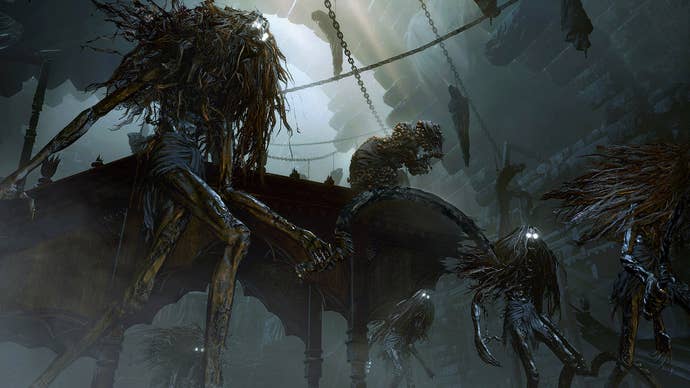
InterfaceBloodborne definitely brings FromSoftware's cleanest RPG UI to date, meaning you'll be sorting through menus a lot less this time around.
Lasting AppealBloodborne is a beefy RPG to begin with, and its procedural (and optional) Chalice Dungeons offer a wealth of content on top of that. And if you reach the end, you'll definitely want to start a new game and look at those old mysteries with an educated brain.
SoundFromSoftware's outdone themselves in terms of sound design; many times, I had to rely on directional audio to figure out the location of my nearest threat.
Visuals These beautifully rendered, Gothic-themed environments look absolutely gorgeous and communicate Bloodborne's melancholy mood effectively.—it's a shame that co-op and some of the larger areas don't offer the greatest frame rate.
ConclusionRefreshingly, Bloodborne knows what it is, and doesn't stray too far from the Souls formula—but its few alterations make for a fresh experience that will challenge even the most hardened Souls veterans. If you're looking to justify the purchase of a PS4, I can't think of a better reason.
Misery Loves Company
Mercifully, you won't have to tango with Bloodborne's difficulty all by yourself; just like in the Souls series, it provides a co-op system that fits neatly within its world's lore—and one with the same degree of restrictions. Co-op revolves around the use of two bells: The Beckoning Bell, which pulls co-op friends into your world, and the Small Resonant Bell, which signifies your interest in being summoned. And while there's no Hollowed/Human states to complicate mechanics this time around, Bloodborne will only let you summon players if you haven't yet finished off the boss of your current area: A smart choice, seeing as the overall point of summoning is taking out whatever horrible thing stands between you and the next area.

It's a system I like a little more than Souls', at least in theory. Instead of having to scour the landscape for summon signs, you can simply ring the Beckoning Bell and get on with your life as it searches for players to pull into your world. Ringing said bell consumes a single point of a resource called Insight, but, from my experience, there's more than enough to go around in Yharnam—even if it's a little annoying that you're not refunded if the Bell fails to do its job. FromSoftware hasn't made playing with your friends any easier, though; as with their past games, it's intended to be anonymous, though they do provide a way to work outside of the game itself to set things up. After being summoned into someone else's world and failing to kill the boss, he contacted me through PSN, and gave me a four-digit password so we'd be able to meet up again instantly. It took a few minutes, but, after feeding this info to Bloodborne, we found each other and did what needed to be done.
Now, I say I enjoy Bloodborne's multiplayer in theory because, in practice, things haven't always worked out the way I expected. When Dark Souls 2 launched, for instance, you could summon and be summoned almost instantly thanks to the sheer amount of people playing at once. That isn't the case for Bloodborne, though I'm not sure if it's due to first-week server jitters or behind-the-curtain math making summoning more restrictive than it appears—and the community hasn't yet figured out the math behind this mechanic. For a game as big as Bloodborne—and one where you can play with the worldwide community—I really expected to be able to jump right into multiplayer at any moment, but the waiting time has been pretty drastic. It's regularly taken at least 10-20 minutes to be summoned or to find a partner, but sometimes, it doesn't happen at all. Granted, it's great that you don't have to re-ring the Bell if your co-op partner dies, but that hasn't helped me much: The one time this happened, Bloodborne searched the world for players until I grew tired of waiting and decided to fight the boss myself.
Still, the times I've been able to do co-op have definitely been worthwhile, which makes me hope the current state of things is only temporary. Unfortunately, your partner doesn't always materialize within your sight when they arrive, which can lead to a bit of initial confusion, but that's only an issue in some of the larger, outdoor areas. As with Souls, if you get someone who knows what they're doing (presuming you do as well), it's possible to absolutely steamroll everything in your path. Most enemies can only target one player at a time, so getting one of them between the two or three of you usually spells instant victory—though it's still possible to get overwhelmed.
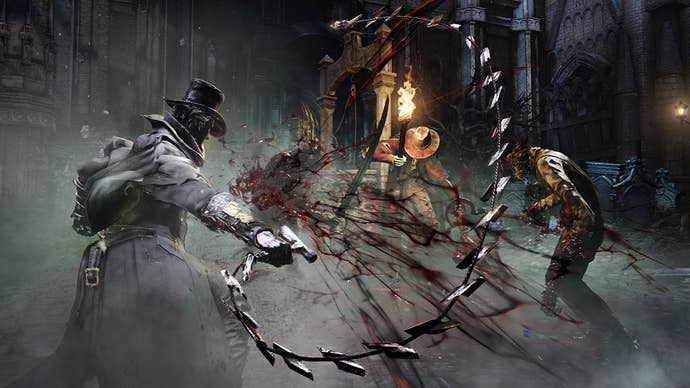
Co-op also adds a new wrinkle that isn't always present in single-player: Ringing the bell attracts an enemy known as "the bell ringing woman," who increases your chances of being invaded unless you track her down and kill her. Again, a good idea in theory, but not something that's affected my game to date; I haven't been invaded in all my many, many hours with Bloodborne, and any attempts to use the Sinister Resonant Bell—which allows you to invade other worlds—have been fruitless. That may be ideal if you'd like to cruise through Bloodborne without being hampered by other players, but I'd at least like to know this mechanic works.
This analysis of Bloodborne's multiplayer isn't quite as comprehensive as I'd like it to be, but my hands are more than a little tied right now—I planned on going into how multiplayer works out in the co-op-focused Chalice Dungeons, but I haven't had much luck summoning other players when I tried. With any luck, these issues will be temporary—we've already heard word that an incoming patch will soon fix more than a few outstanding issues—including the load times—so hopefully, whatever's keeping multiplayer from reaching its full potential will soon be fixed. And hopefully, these vague promises of "optimization" will include Bloodborne's framerate; while it's perfectly fine in single player, it can take some pretty severe dips with co-op, especially in larger areas. With any luck, this review will soon be a time capsule documenting Bloodborne's rocky—but quickly improved—launch.
InterfaceBloodborne definitely brings FromSoftware's cleanest RPG UI to date, meaning you'll be sorting through menus a lot less this time around.
Lasting AppealBloodborne is a beefy RPG to begin with, and its procedural (and optional) Chalice Dungeons offer a wealth of content on top of that. And if you reach the end, you'll definitely want to start a new game and look at those old mysteries with an educated brain.
SoundFromSoftware's outdone themselves in terms of sound design; many times, I had to rely on directional audio to figure out the location of my nearest threat.
Visuals These beautifully rendered, Gothic-themed environments look absolutely gorgeous and communicate Bloodborne's melancholy mood effectively.—it's a shame that co-op and some of the larger areas don't offer the greatest frame rate.
ConclusionRefreshingly, Bloodborne knows what it is, and doesn't stray too far from the Souls formula—but its few alterations make for a fresh experience that will challenge even the most hardened Souls veterans. If you're looking to justify the purchase of a PS4, I can't think of a better reason.
A Cruel New World
Before Bloodborne's launch, director Miyazaki hinted his new game would have an atmosphere along the lines of Demon's Souls' Tower of Latria: A dank, dark prison where deadly, squid-headed guards prowl the squalid corridors. And, after living with Bloodborne for a solid week, I'm happy to say he's definitely achieved this goal. The Souls games didn't exactly have the brightest and happiest settings, but they'd usually offer a few rare moments of beauty to throw the surrounding decay of the post-apocalypse into sharp relief. In contrast, Bloodborne begins just after the s**t's already hit the fan, and things only get worse from there. It's difficult to discuss without going into major spoilers, but Bloodborne does an excellent job of gradually closing off the few remaining bastions of hope you encounter—and certain story events alter areas you've already visited, making those return trips full of new dangers. It's easy to see why the few living (and at least slightly sane) citizens of this world choose to live out the remainder of their lives cowering behind locked doors.
FromSoftware's worked mainly in the fields of high and dark fantasy with their past three RPGs, so Bloodborne's Gothic theme goes a long way towards making the experience feel fresh. And if you dig Lovecraftian horror, there's definitely a lot to love here; while the Souls games occasionally dipped into this author's works for inspiration, Bloodborne practically feels like Lovecraft fan fiction—in a good way! It's always been difficult for games to capture his unique style effectively, because so much of his works rely on your imagination to fill in the blanks. Here, FromSoftware does their best to capture Lovecraft's eldritch horrors, and, as the game unfolds, Bloodborne's enemies go from your standard human/animal mutations to unspeakable, asymmetrical beasts—there's even a few that induce a state called "Frenzy" if you gaze at their horrifying state of existence for too long. And though From's attempted it in the past, to date, Bloodborne features their most impressive boss made entirely of corpses—that's gotta be an achievement somewhere.

And Bloodborne's bosses definitely make for some of the game's greatest moments, even if the camera doesn't always cooperate. If you grew tired of the Dark Souls 2's "duel" bosses—one-on-one encounters with humanoid enemies—Bloodborne will definitely speak to you. Though there's some freedom in the order you approach them, each boss I fought offered a different experience from the last, with the few human-sized opponents often bringing me the biggest challenges—especially when fighting other hunters who possess the same stun mechanic. True, Miyazaki reuses some ideas from his Souls games, but he also refurbishes them, giving these old encounters some new twists you might not expect. True, a few can be incredibly frustrating, but I never felt as if any were cheap or lazily designed, no matter how many times I had to stare at the Bloodborne logo seconds after they finished me off.
While it's true Bloodborne emphasizes aggressive, risk-taking strategies, there's still a little bit of wiggle room to work with. As weapons work their way through the standard upgrade paths, you can add runes to them, which confer certain bonuses, and can even give your arms a specific elemental trait. Characters can even equip themselves with runes, which act much like rings in Dark and Demon's Souls, offering passive abilities like stronger attacks and an increase in max HP. There's much less anxiety behind upgrading in Bloodborne, though: Weapons can only get stronger, and runes can be swapped on and off at will. Admittedly, I kind of enjoyed the risk of making mistakes via upgrades with the Souls games, but once you figure out the system, it's essentially impossible to mess up—Bloodborne simply makes it so all upgrades are beneficial, which cuts out a bit of micromanagement on the player's part. If anything, I get the sense Miyazaki wanted to trim the inessential elements of Souls—even if they added some depth.
And really, that's what I'm picking up the most from Bloodborne: While the Souls games offer a variety of ways to play, and an almost limitless amount of customization options, this latest RPG makes some sacrifices—a few of them slightly controversial—for a more focused experience. True, the weapons each feel very different from each other, but how you'll use them to approach enemies should follow the same tack. And while it's easy to see Bloodborne as a step down from Souls in this respect, I'm actually grateful for how much it took me out of my comfort zone. In the course of my time with the game, I went from semi-hopeless and fumbling to beating two bosses back-to-back on my first try. That isn't a shameful attempt to brag about video game achievements, by the way; I'm honestly impressed by the way Bloodborne forced me to learn its rules and then made me feel absolutely unstoppable once I adapted to them.
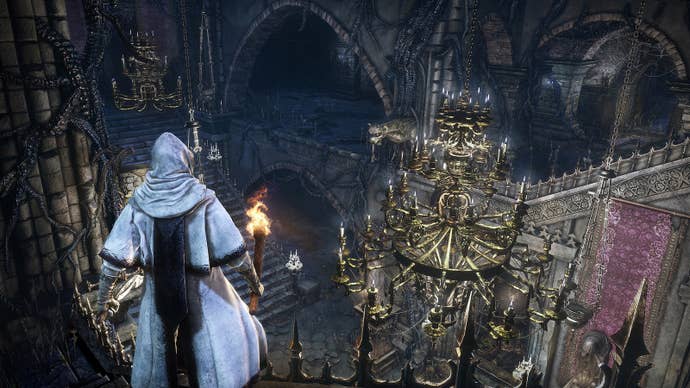
It goes without saying, though, that Bloodborne isn't a simplified version of Souls; while it's not nearly as sprawling as Dark Souls 2, the settling still provides a lengthy tour through some memorable areas—your first trip through should take around 50 hours. And, as with any game of the Souls lineage, those second and third playthroughs end up being the most meaningful: Only then can you really put together the pieces that explain this chaotic and disjointed world. It's a shame, then, that technical issues mar the experience somewhat—even though that's been the case with past FromSoftware releases on consoles. If the developer could somehow snip the load times in half and make it so co-op wasn't quite as hard to come by, it'd definitely improve my experience significantly. This morning, I waited in vain for 20 minutes as I desperately tried to find a co-op partner for an especially tricky boss—surely there had to be someone, somewhere in Bloodborne's worldwide community who could have offered their help?
Since its release, I've been asked how Bloodborne measures up to the Souls games, and really, I think I need a little more perspective before I can fully weigh in on this issue. Even so, Bloodborne's various simplifications make for a meaningfully different experience, and while I certainly haven't tired of Souls games, it's been a lot of fun to see this same philosophy funneled through a different context. FromSoftware's had an amazing track record of late—it seems like they've given us non-stop content over the past year—and, thankfully, Bloodborne doesn't stand as their first major slip-up. It's definitely an experience in need of optimization, but also an incredibly memorable one that stands as the strongest console-exclusive game in years. If you want to see the future of RPGs, it all begins with Bloodborne.
InterfaceBloodborne definitely brings FromSoftware's cleanest RPG UI to date, meaning you'll be sorting through menus a lot less this time around.
Lasting AppealBloodborne is a beefy RPG to begin with, and its procedural (and optional) Chalice Dungeons offer a wealth of content on top of that. And if you reach the end, you'll definitely want to start a new game and look at those old mysteries with an educated brain.
SoundFromSoftware's outdone themselves in terms of sound design; many times, I had to rely on directional audio to figure out the location of my nearest threat.
Visuals These beautifully rendered, Gothic-themed environments look absolutely gorgeous and communicate Bloodborne's melancholy mood effectively.—it's a shame that co-op and some of the larger areas don't offer the greatest frame rate.
ConclusionRefreshingly, Bloodborne knows what it is, and doesn't stray too far from the Souls formula—but its few alterations make for a fresh experience that will challenge even the most hardened Souls veterans. If you're looking to justify the purchase of a PS4, I can't think of a better reason.





